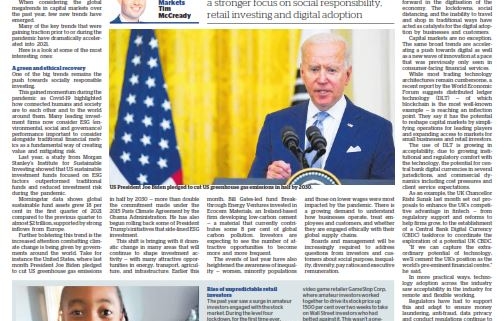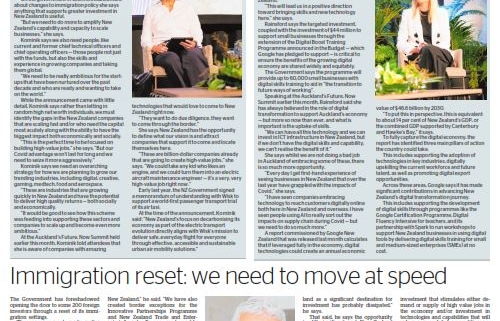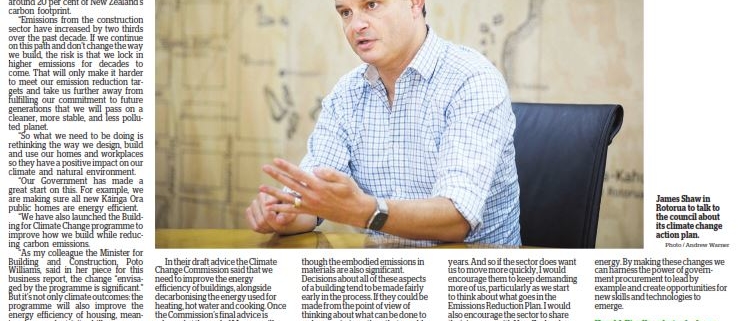Capital Markets report: Megatrends shaping the markets
Living through a global pandemic has seen existing trends in capital markets accelerated.
When considering the global megatrends in capital markets over the past year, few new trends have emerged.
Many of the key trends that were gaining traction prior to or during the pandemic have dramatically accelerated into 2021.
Here is a look at some of the most interesting ones:
A green and ethical recovery
One of the big trends remains the push towards socially responsible investing.
This gained momentum during the pandemic as Covid-19 highlighted how connected humans and society are to each other and to the world around them. Many leading investment firms now consider ESG (environmental, social and governance) performance important to consider alongside traditional financial metrics as a fundamental way of creating value and mitigating risk.
Last year, a study from Morgan Stanley’s Institute for Sustainable Investing showed that US sustainable investment funds focused on ESG factors outperformed traditional funds and reduced investment risk during the pandemic.
Morningstar data shows global sustainable fund assets grew 18 per cent in the first quarter of 2021 compared to the previous quarter to almost $2 trillion, supported by strong inflows from Europe.
Further bolstering this trend is the increased attention combatting climate change is being given by governments around the world. Take for instance the United States, where last month President Joe Biden pledged to cut US greenhouse gas emissions in half by 2030 — more than double the commitment made under the 2015 Paris Climate Agreement by the Obama Administration. He has also begun rolling back some of President Trump’s initiatives that side-lined ESG investment.
This shift is bringing with it dramatic change in many areas that will continue to shape investment activity — with many attractive opportunities in energy, transport, agriculture, and infrastructure.
Earlier this month, Bill Gates-led fund Breakthrough Energy Ventures invested in Ecocem Materials, an Ireland-based firm developing low-carbon cement — a material that currently contributes some 8 per cent of global carbon pollution.
Investors are expecting to see the number of attractive opportunities to become more and more frequent.
The events of last year have also heightened the awareness of inequality — women, minority populations and those on lower wages were most impacted by the pandemic.
There is a growing demand to understand how businesses operate, treat employees and customers, and whether they are engaged ethically with their global supply chains.
Boards and management will be increasingly required to address questions from investors and customers about social purpose, inequality, diversity, pay ratios and executive remuneration.
Technology adoption set to continue
One of the most omnipresent trends over the past year has been the leap forward in the digitisation of the economy. The lockdowns, social distancing, and the inability to travel and shop in traditional ways have acted as catalysts for the digital adoption by businesses and customers.
Capital markets are no exception. The same broad trends are accelerating a push towards digital as well as a new wave of innovation at a pace that was previously only seen in consumer-facing financial services.
While most trading technology architectures remain cumbersome, a recent report by the World Economic Forum suggests distributed ledger technology (DLT) — of which blockchain is the most well-known example — is reaching an inflection point. They say it has the potential to reshape capital markets by simplifying operations for leading players and expanding access to markets for small businesses and retail investors.
The use of DLT is growing in acceptability, due to growing institutional and regulatory comfort with the technology, the potential for central bank digital currencies in several jurisdictions, and commercial dynamics including cost pressures and client service expectations.
As an example, the UK Chancellor Rishi Sunak last month set out proposals to enhance the UK’s competitive advantage in fintech — from regulatory support and reforms to help firms grow, to the establishment of a Central Bank Digital Currency (CBDC) taskforce to coordinate the exploration of a potential UK CBDC.
“If we can capture the extraordinary potential of technology, we’ll cement the UK’s position as the world’s pre-eminent financial centre,” he said.
In more practical ways, technology adoption across the industry saw acceptability in the industry for remote and flexible working.
Regulators have had to support this and adapt to ensure money laundering, anti-fraud, data privacy and conduct regulations continue to be equivalent whether working from the office or working from home.
But there are still concerns around market abuse and cybersecurity that come with remote working, and whether this trend will persevere long-term following the relaxation of lockdowns around the world remains to be seen.
New Zealand demonstrated that the lack of personal contact after so long working remotely, along with Zoom fatigue, saw most working in capital markets return to the office.
However, the inability to entirely wind back the new remote working culture has made flexible working a likely requirement for capital markets of the future.
Rise of unpredictable retail investors
The past year saw a surge in amateur investors engaged with the stock market. During the level four lockdown, for the first time ever, amateur investors were more active than professional investors in New Zealand.
Services like Sharesies and Hatch have created accessible platforms for retail investors to engage in share trading without needing to go through traditional fund managers. Their rapid growth in interest has been attributed to the pandemic keeping people idle at home, low interest rates limiting savings returns and many people being shut out of the property market.
But recent months have seen another factor come into play — the rise of social media-driven traders. The most well-known example is video game retailer GameStop Corp, where amateur investors worked together to drive its stock price up 1500 per cent over two weeks to take on Wall Street investors who had betted against it. This wasn’t a one-off, with other stocks including BlackBerry and Nokia targeted.
These investors are unpredictable and bullish and have rattled sophisticated professional investors. As a result, the chair of the US Securities and Exchange Commission, Gary Gensler, is considering new rules for apps that “gamify” trading and use visual graphics to reward an investor’s decision to trade.
“The SEC must remain attuned to rapidly-changing technologies with an eye to freshening up our rules,” says Gensler. “If we don’t address this now, the investing public, those saving for retirement, and education, may shoulder the burden later.”






